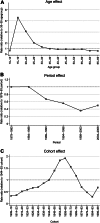Age, period and cohort effects on the incidence of motorcyclist casualties in traffic crashes
- PMID: 22753530
- PMCID: PMC3664376
- DOI: 10.1136/injuryprev-2012-040345
Age, period and cohort effects on the incidence of motorcyclist casualties in traffic crashes
Abstract
Objectives: (1) Estimate age, period and cohort effects for motorcyclist traffic casualties 1979-2008 in New Zealand and (2) forecast the incidence of New Zealand motorcycle traffic casualties for the period 2019-2023 assuming future age, cohort and period effects, and compare these with an estimate based on simple linear extrapolation.
Methods: Age-period-cohort (APC) modelling was used to estimate the individual effects of age, period and cohort after adjusting for the other two factors. Forecasting was produced for three period-effect scenarios.
Results: After adjusting for cohort and period effects, 15-19-year-olds have substantially elevated risk. The period effect reduced in significance over time until the last period, 2004-2008, where the risk was higher than the preceding period. The 10-year cohorts born 1949-1958, 1954-1963, 1959-1968 and 1964-1973, had elevated risk. The forecasting, based on APC modelling, resulted in the lowest estimates of the future incidence being approximately one-third that of the highest estimate (6641).
Conclusion: Trends in motorcycle casualties have been influenced by significant independent age, period and cohort effects. These need to be considered in forecasting future casualties. The selection of the period effect has a significant impact on the estimates. Which period-effect scenario readers choose to accept depends on their views about a wide range of factors which might influence motorcycle use and crash risk over time.
Keywords: MVTC; Motorcycle; adolescent; advocacy; age; behavioural; cohort; forecasting; interventions; legislation; methodology; period; populations/contexts; public health; surveillance; terminology.
Conflict of interest statement
Figures



References
-
- International Transport Forum A Record Decade for Road Safety. Paris, 2010
-
- Ministry of Transport Motor Vehicle Crashes in New Zealand 2009. Wellington; Organisation for Economic Co-operation and Development, 2010
-
- Morris C. Motorcycle Trends in the United States. Washington, US Depart of Transportation: Bureau of Transportation Statistics, 2009:6
-
- Ministry of Transport Ministry of Transport Safer Journeys: New Zealand's Road Safety Strategy 2010-2020. Wellington, Ministry of Transport, 2010
-
- Statistics New Zealand National Population Projections: 2004 (base)—2051. Wellington: Hot Off The Press, 2004
Publication types
MeSH terms
LinkOut - more resources
Full Text Sources
